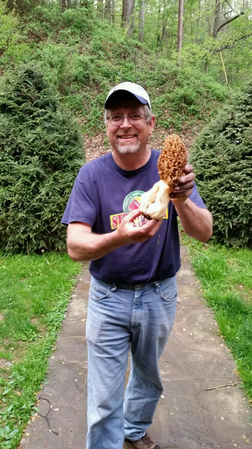 Searching for morels is a combination of an outdoor adventure and a treasure hunt! Courtesy of Tony Street Searching for morels is a combination of an outdoor adventure and a treasure hunt! Courtesy of Tony Street The next question is, when do I hunt? There are several varieties that come up throughout spring. The time to start looking in the forest is when the undergrowth (trillium, May apples, wildflowers, etc.) comes alive and the redbuds begin to bloom. Temperature, moisture, and sunlight all play into the equation. The Ideal temperature range takes place when it stretches into the 60s during the day while the night doesn’t dip below the 40s. Mushrooms like the soil moist, but not soaked, and the sun to warm the ground. A great time to look is the day after a rain, when the sun is out and the temperature range is right. Where do I look? That’s the question, isn’t it? This again has parallels to fishing. There are places that are more likely to have mushrooms just like there are places in a lake that are more likely to hold fish. However, that doesn’t mean they’ll be there. All I can do is share what I’ve learned. The best advice I can give you is that often, and I mean very often, mushrooms will come up in the same place year after year. That’s one reason experienced hunters come back with more mushrooms. They make a beeline for where they’ve found them in the past. And don’t waste your time asking them where they’ve found their haul. It’s like asking a fisherman where he caught his stringer of fish! He won’t tell you exactly, just generally. He found it and as far as he is concerned, that place is now HIS SECRET! So, keep a mental or written log of everywhere you find mushrooms. And remember, we now have modern technology… even in our phones. Using a GPS to mark your spot is not against the rules. My father, Kenneth has a system. He looks under and around Ash, Elm and Tulip Poplar trees. I’ve also been told by others that a good place to look is around the base of larger Sycamore and Cottonwoods. My mother, Mildred likes to look around fallen, dead or dying trees. Decaying roots and tree material is an ideal food source for mushrooms. The real challenge to finding Morels anywhere is actually seeing them! They blend right in with the leaves making it easy to walk right past without notice. In fact, beginners walk by many more than they ever find. The best way to see one is to walk in a crouched manner looking not down at your feet, but 10 to 20 feet ahead seeking their distinctive cone shape outline. And when you find one, STOP. My father taught me that where there is one, there is often more. Sit down next to your find and calmly look in every direction. If you don’t see any, take your walking stick and closely look through the surrounding brush and leaves. More likely than not, you’ll find more! There are several varieties of Morels to train your eyes to find. The first to emerge in the early spring are the black Morels. They are typically smaller but are especially tasty with a very strong flavor. The greys (also called whites) are next and are larger and taste great. However, my favorite is the yellow. It’s the last variety to come up and are the largest of the varieties I have found them reaching up to 6 inches or more in height. Once you finish your hunt, and have recorded your now SECRET HUNTING SPOTS, it’s time to prepare your find to eat. My mother prepares hers as her mother, Fyrne did. The first thing is to soak them in cool salted water. There are multiple cavities in the crown of the Morel, which house a multitude of small insects. Soaking in salt water drives these creatures out from their hiding places and avoids adding unwanted protein to your meal! Also, remember to NOT pour your soaking water down the drain. It’s now loaded with Morel spores! My mother ALWAYS pours her water at the edge of the woods behind the house. She’s been doing it long enough that Morels now pop up each spring! Cooking is a matter of preference. Morels are great sliced and sautéed with onions. However, my family is from the country and we like ours sliced, rolled in flower and fried in butter! My father and I prefer eating them between two slices of white bread. He even spreads on a layer of butter! This method may not be the healthiest, but the warm & uniquely meaty flavor of the mushroom covered in the crunchy texture of the fried batter surrounded by the soft white bread is heaven to the palate! I love Morels! And after doing the research for this article, I can’t wait to start hunting! But, before I go, I have to share with you one more thing I discovered. There is an amazing variety of Morel I had never heard of before. It’s called the Bigfoot Morel and a single mushroom can weigh up to 4 pounds! No wonder it’s called a BIGFOOT! They are relatively common in the states north of us, and after some more internet research, I discovered several posts where people have found them in Tennessee. I’m excited! I now have a new goal: finding a Bigfoot Morel mushroom! I could feed my whole family with just one! I encourage you to try your luck hunting Morels. Even if you don’t find a one, the day won’t be a waste. The peace and beauty found in the woods can’t be matched by the structures created by man. God is still the master craftsman and always will be. So, enjoy your day in the woods, embrace the special gift that it is and praise and give thanks to the Creator of it and you! 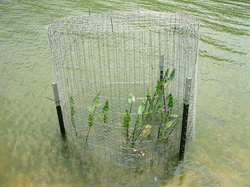 4’ diameter cages 4’ diameter cages OK… I have to admit something. I was going to totally ignore an early failure of mine with Fyrne Lake in this series, but my story wouldn’t be complete if I do! In my last article I steered clear of mentioning any of my early efforts at establishing plants in the lake. I’m sure that’s because it was a total and utter DISASTER! It consumed an amazing amount of time, effort and not a small amount of money. You see, I thought I had it all figured out. This successful entrepreneur from Florida (me) was going to outsmart these backwoods Tennessee grass carp (actually they’re from Asia – but I didn’t know that at the time). It all started with my desire to establish plant life in Fyrne Lake. Ideally a lake or pond ecosystem includes aquatic plants in the shallows with larger natural and/or manmade structures stretching out into the depths. I knew I could handle the larger structures (see my last article). I also was aware that establishing aquatic plants would be a challenge until we reduced the number of grass carp in the lake. Reducing their numbers would take time and I didn’t want to wait! I immediately started devising a plan to create multiple fenced in “carp free zones” in the shallower areas of the lake. I realized that the grass carp would consume any plants that grew out beyond the fence, but that was part of my plan. I knew we would eventually thin the grass carp out enough that the aquatic plants’ growth would reach a critical mass where the plants would grow out beyond the fence more quickly than they could be consumed. Once that happened, we would be winning the war against the grass carp. At least that was my plan. Before we created these barrier structures, we needed to select what plants would go in them. Selecting the right mix was going to be important and I had to avoid ANY that might take over the lake. We were lucky; most of Fyrne Lake’s bottom exceeded 6 feet which was the max depth that most (but not all) aquatic plants could survive. I called my lake consultant, spent hours researching on the internet and contacted several aquatic plant nurseries. Eventually, I settled upon three species: Pickerel Weed (Pontederia cordata), American Pondweed (Potamogeton nodosus), and Fragrant Water Lily (Nymphaea odorata). Each plant performed a specific function in the lake. The Pickerel Weed would occupy the most shallow zone, from the wet soil of the shoreline to 6 inches of water depth with some plants creeping out to as much as 18 inches. In full sun Pickerel Weed will densely occupy this zone creating a shore erosion barrier from waves or wake. The American Pondweed would share the shallow water zone of the Pickerel Weed and beyond stretching out to 36 inches of water depth with some plants surviving up to 48 inches. The dense growth of these two aquatic plants would provide exactly what our shoreline baitfish species (fathead minnows and golden shiners) needed to survive and multiply, thereby significantly increasing Fyrne Lake’s food supply. The Fragrant Water Lily (commonly known as lily pads) would perform a completely different role in my plan. Their structure isn’t nearly as dense, consisting of long slender steams reaching up from the bottom and ending with floating leaf 4 to 12 inches in diameter. Their function is to provide structure for game fish to hide among to ambush baitfish and hopefully fishing lures! These plants will grow in water depths of up to 6’ completing my planned shoreline fish habitat without taking over the areas of the lake with greater depths. Two of the three aquatic plants also had a cool side benefit… beautiful blooms! Many of you are probably familiar with the large white floating flowers associated with lily pads, but are you familiar with the unique purple flowers of the Pickerel Weed? These plants grow from 2 to 4 foot tall with spikes containing multiple small (less than ½ inch) violet flowers each with two yellow spots. The nectar attracts bees (great for our honey production), the seeds are a great food source for ducks while their leaves are a treat for deer and muskrats (more on that later). Now it was time to create the grass carp free zones! We started with 15 round structures made from 50’ rolls of 4’ tall perimeter fencing wire. Each one would be installed in 1 to 2 1/2 foot of water toward the shallower end of Fyrne Lake’s coves. It took three of us working a full week to install and plant these structures. Would they keep out the carp? We would soon find out! Soon the cages were filling up with plants! We also discovered an exciting side benefit. Baitfish and gamefish fry had quickly discovered the sanctuary they provided. The summer went on and the lily pads began blooming! They were beautiful and the cages were working! Wow, it looked like things were turning out amazingly well. But I was about to discover that I was celebrating prematurely. As the summer was wearing on we noticed a few lily pads reaching out beyond the fence. That was a good sign. And the fact that they disappeared soon after wasn’t a surprise; it was expected. However it wasn’t long before we noticed other plants disappearing… from within fencing! How could that be?!? Were the grass carp finding a way in? Fisherman had noticed that the grass carp had been bumping up against the cages trying to get to this new and very interesting salad. But these fish were huge weighing in at 40 pounds or better! There was no way any of them could fit through the small openings in the fence. So why were the plants disappearing from the interior of the rings? I put on my waders and we headed out into the lake to check the structures out. No holes! What was happening? The answer soon came from a fisherman, “Hey Kevin! I just saw a muskrat in the lake with a lily pad trailing behind!” OH NO! I wasn’t just fighting the grass carp, the muskrats have joined in! Desperately I attempted to salvage our work. We figured the muskrats were squeezing through the 2” x 4” holes in the fencing. We purchased 15 roles of fine mesh wire fencing and replacement plants. Then we proceeded to wrap each fence ring with the new material. For a time our efforts seem to be working. The plantings recovered and again started reaching out beyond their enclosure. Then the cycle began repeating itself. Plants started disappearing from the outside, then the inside of several enclosures. The signs pointed back to the muskrats. It appeared that once attracted back to the rings by the plants growing out through the exterior, they figured out how to climb the fence to reach the interior. They’re intelligent little varmints!!! We had to regroup! A season passed and I decided to give it one more major try. THIS TIME I thought I had figured out a FINAL solution … at least I hoped! First, we removed over half of the existing fence rings where the plants had been decimated. Next we created 50 smaller diameter (4 foot) “enclosed” cages that included a wire mesh top. Surely this design would keep out the muskrats! This plan quickly evolved into a huge project consuming several weeks of effort in construction and installation. Finally our job was complete and as before, plants (and small fish) started to thrive within the comfort and protection of our structures. It looked like our efforts were finally beginning to pay off. After a steep learning curve it looked like we were winning the war. But no, not even close! Structure after structure soon were emptied of all plant life … but how? It turned out that these cute, little and apparently very intelligent aquatic mammals were as determined to get to my plants as I was to protect them. After a few months of watching their crop grow safely protected from the grass carp from within these new structures, they simply burrowed under the fence to harvest the bounty! I was devastated and admitted that I had met my match and surrendered to the reality of the situation. We would waste no more effort on establishing aquatic plants until the grass carp (and muskrats) were under control! Until then I would concentrate on adding natural and manmade structure to the lake. This experience taught me two valuable lessons. There are usually more variables (and enemies) in a situation than you initially see and when you think you’ve got it all figured out… check again! Over confidence can be your own worst enemy. Managing Fyrne Lake has been much more than I ever bargained for! However, I’m not complaining! I love the experiences I’ve had tackling each successive challenge in my pursuit of making Fyrne Lake a first class fishery. More articles are in the works for future issues that will cover other aspects of our management of Fyrne Lake and our efforts to care for the land, wildlife and forest of my family’s farm. I’m looking forward to sharing them with you! 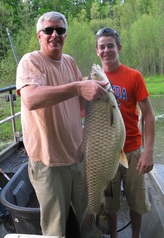 Walt Bradshaw with his son Walt Bradshaw with his son (40+ pound grass carp) Picture taken in 2010 Fish love structure! Most fish need structure in which to hide, to hunt and to spawn. Small fish feel stressed without it and rightly so! Without cover to hide in or behind they are easy prey for the ever present predators. Predator fish love structure from which to pounce on their next meal. And most fish prefer spawning in, near or on structure to provide cover for their newly hatched fry. Structure is necessary for a healthy and vibrant fishery. My problem was that when I acquired Fyrne Lake in 2004 there was virtually no structure. Like many manmade lakes, its bottom was totally cleared of trees and debris during its construction in 1978. Luckily, as the lake filled, birds and wind brought in aquatic plant seeds which quickly took root and began multiplying. This plant growth provided the cover the newly stocked fish required to flourish and in just a few short years Fyrne Lake (known as Viar Lake until 2004) provided excellent fishing. There was only one problem. A few of the fisherman complained to the former owner that the plants made it difficult to get their lures to the fish. That reinforced his fear that these aquatic plants might take over the lake. He didn’t need to worry. 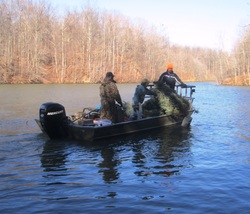 Christmas trees staged for placement Christmas trees staged for placement Picture taken in 2012 For a healthy fishery, at least 5% to as much as 25% of a lake should be dominated by aquatic plants. Most of our area’s native aquatic plants require depths of 6 feet or less to flourish. Fyrne Lake is a deep lake averaging 15 – 18 feet with most depths away from cove ends reaching beyond 6 feet not far from shore. There was little chance that Fyrne Lake would ever develop a weed problem. However, the previous owner panicked and overreacted by stocking too many grass carp. A few may have been OK. However, he stocked about 1000 too many. It didn’t take long before these grass carp ate every shred of aquatic plant in the lake. White Amur, commonly called grass carp, are an Asian minnow species that can grow up to 100 pounds! They’re vegetarians and can consume 2 to 3 times their weight each day. Unlike the common carp which has a sucker like mouth, grass carp have a normal mouth followed by a series of teeth in their throat that tear plant material as they swallow. These plant eating machines made short work of the existing aquatic plants and then set their sights on the leaves within their reach on tree branches overhanging the water. Soon the bottom of the trees along the shoreline looked manicured! The trees were beautiful and the water was clear of weeds. The owner was happy and the fisherman could cast where they wanted. The problem was that the lake was back to having virtually zero structure. The gamefish fry and baitfish had nowhere to hide which allowed the larger gamefish to have a field day consuming everything in sight. Soon the lake reached an unhealthy equilibrium, zero baitfish, quickly consumed gamefish fry, gigantic bream (the ones too larger to be eaten by bass) and an overpopulation of stunted bass. As I stated in a previous article, bass tend to overpopulate and stunt in manmade lakes anyway. However, this lack of cover sped up the process. And by the time I had purchased the lake in 2004, it had been in dire need of care for many years. 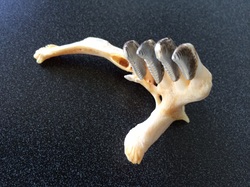 Right side of grass carp jaw, showing the Right side of grass carp jaw, showing the throat teeth used for shredding plant material, as the fish swallow. In my last article, I shared with you our three prong lake management plan for Fyrne Lake. Removing unwanted fish (yellow bass “stripes”, catfish, grass carp & largemouth bass under 12”), pumping up the food chain, and adding substantial amounts of fish structure. Removing the grass carp would help me add acres of natural fish structure in the form of aquatic plants. We started removing every grass carp we could through netting and electro-shocking. We even put a bounty (a Fyrne Lake honey bear) on the head of any grass carp brought in by a fishing club member. One by one we began removing these 40 pound plus monsters. However it was going to take years before we removed enough grass carp to make a difference. We needed to find other ways to add natural and artificial structure now! I came across a product at a bait shop that was at that time call the O-No Hang Fish Attractor (the name eventually was changed to The Porcupine Fish Attractor). It was a unique looking contraption with a central globe and 26 holes to accept ½” diameter PVC pipe. The inventor, Larry Harper, lived in Paducah, KY and was at the time doing all of his own marketing and sales. I gave him a call and made a deal on 100 O-No Hangs. I was excited and so was he! It wasn’t long before he showed up with all 100 attractors and almost as many questions. Larry was a crappie fishing fanatic and had created his invention for fisherman to create their own fish attractors in public waters. I owned private waters and he was on a research mission to understand what opportunities might exist for him and his product in this market. I did my best to answer his questions and went further by introducing him to lake management firms who served private lake and pond owners. He was thrilled and it wasn’t long before we had a deal on an additional quantity of attractors. In addition to the Porcupine Fish Attractors, we cut down trees along the shoreline that were leaning over the lake. They would have eventually fallen anyway… I just didn’t want to wait! We also created stake beds out of cane and bamboo. I discovered a video at Crappie101.com (http://www.crappie101.com/crappie/how-create-a-crappie-stake-bed) that not only described how to make an effective stake bed, but also how to construct a tool out of PVC pipe that speeds installation. The tool enabled us to place hundreds of 4-5’ long cane/bamboo posts in just a few hours. Our efforts were beginning to make a difference! These various structures were gathering fish making them easier to be caught by fisherman. However these structures did not provide much cover for minnows or small game fish fry. We needed mass quantities of dense shallow cover for them. Again, I knew that aquatic plants would be THE ideal answer and someday these plants would return. For now we needed another way. We started out trimming tree branches along the shoreline and laying them down in the shallows creating mini-brush piles. We also took advantage of a temporarily available free source of structure… discarded Christmas trees! Their use is not a new concept, nor do they last very long (3-5 years on average) but, they were exactly what we needed to add dense, shallow cover for baitfish. We placed multiple Christmas trees horizontally, in shallow water, weighed down by cinder blocks. We also vertically dropped groups of trees in deeper water, with cinder blocks attached to the bottom of their trunks, causing them to settle down into the mud as if they had been planted. In deeper water installations we thinned out some of the Christmas tree branches allowing larger fish to hide between them. Using temporary floats to mark the location of each tree as we sank them, allowed the creation of accurately spaced forests of fish habitat! 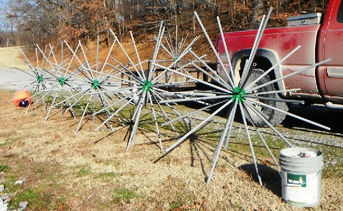 Here is one of the five deep-water structures installed in 2012 Here is one of the five deep-water structures installed in 2012 Each one consisted of five Porcupine Fish Attractors, threaded into crab trap rope, held up by an inflatable offshore float and kept in place with five gallon bucket filled concrete. Photo by author Our efforts were adding up and the fish and fishermen were responding positively. However, we weren’t done yet! Fyrne Lake is a deep lake, much of it over 20’ with some areas approaching 40’. With the addition of our open water baitfish (the threadfin shad discussed in our last issue) and our increasing crappie population, deep water structure could add a new fishing dimension to the lake. I had an idea! In the ocean, greenbacks (the threadfin shad’s saltwater cousin) gather in huge schools around buoys and other offshore structures. What if we created an offshore structure of our own! I envisioned creating a buoy type structure in 30+ feet of water that would include attachments from the surface to the bottom. However, I did not want to only create one, I wanted 5 located within a 40 foot square area to ensure we give this new idea a fair shot at success. Each assembly would consist of a large float suspending five of Larry’s 60” tall Porcupine Fish Attractors threaded with crab trap rope and held down by a 5 gallon bucket of concrete. The key would be locating a float that was rugged enough to stand the test of time and large enough to hold up the weight of the attractors but not lift the 5 gallon bucket. I computed the weight of each and started making calls. It wasn’t as easy as I thought! Even though commercial type floats are rated by weight buoyancy, their engineers couldn’t tell me at what point they would stop lifting making it difficult to determine how much weight I needed to hold each structure in place. Undaunted, I would just have to do a little engineering myself! I ordered 5 inflatable commercial offshore buoys where I could fine tune their buoyancy, a role of crab trap rope, a few bags of concrete and enough ½” PVC pipe to assemble the attractors. By the time the floats arrived, we were ready! Ideally, I wanted the floats suspended just below the surface to be unnoticeable from shore. That would make installation tricky! Our plan was to tie the concrete filled bucket to the crab trap rope, lower the float to the bottom, thread and drop the 5 attractors on the rope one by one and then tie on the float. It sounded simple enough. But, I’ve discovered in life (more than once) that unexpected challenges can occur when a plan meets reality. In your head things like tying a knot in a rope seems simple enough and the first one that we tied on the bucket while it was still in the boat was easy. Threading the 5 attractors on the rope also went rather well. The unexpected knot challenge came while attempting to tie the float on the rope where I wanted it. That required the knot to be tied 3 feet under the surface! In my plan, one of us would just pull the rope up while another would tie on the float. Ha! We had about 100 pounds attached to that rope and one person leaning over the side of the boat could barely hold on. It took two people to lift and hold the rope while the third tied the knot. Whew! We tied it and let go. The float didn’t submerge! Even though I had pumped what I thought was the minimum amount of air in the float it was still too buoyant and the whole assembly started floating away! We retrieved the float and let out some air. It still lifted the concrete bucket off the bottom! After a couple tries we finally had the first structure suspended just below the surface. But, there were still 4 to go! We added a concrete block as extra weight to the second and it helped speed up the process. Eventually, after a lot of on the spot reengineering, we had all 5 buoy supported fish attractors installed and ready to go! One out of the 5 floats protruded above the surface, but that was OK. Rather than lifting it out to retie the knot, we would just leave it as a reef marker. EVERYONE on the boat LOVED the idea! Next question… would this deep water structure work! I knew one way to find out. After a couple weeks of waiting, we slowly cruised over the area with our eyes glued to the depth finder screen. Fish were everywhere! The depth finder indicated that the attractors we holding schools of baitfish just as I had hoped. It was now only a matter of time for the crappie and bass to follow. Every year we add structure to Fyrne Lake. Christmas trees are a given. We’ve partnered with the City of Dyersburg to recycle trees into the lake. We also keep an eye out for desirable bushes and tree cuttings left at two gullies nearby our farm’s entrance. And then there’s our experimental structures! Like the buoy attractors, we’ve always trying out new ideas to keep our fish and fisherman happy! Some have worked well, others haven’t. I promise to share with you the best of our ideas in one of my future articles. I have a plan! by Kevin Griffith It was 2005 and after much research and consultation, I had a management plan! A lake management plan to improve Fyrne Lake. It involved removing unwanted fish (yellow bass “stripes”, catfish, grass carp & largemouth bass under 12”), repairing and pumping up the food chain and adding substantial amounts of natural and artificial fish structure. I was excited and couldn’t wait to get started! The lake had so many needs all interrelated and all of equal importance. Fulfilling one need at a time didn’t make sense, so I jumped in and attacked all three simultaneously! As I shared in the last issue, I immediately enlisted the help of the fishing club members to keep all the unwanted fish they caught and I began a fish stocking program of various desirable baitfish to plug the holes in the lower rungs of the lake’s food chain. But, there was still so very much to do! I also began identifying various designs for natural and artificial fish structures (details next issue) and investigating ways to pump up the lake’s food supply. Could we create a totally new food chain to double up the potential food supply for our gamefish? Maybe… I was definitely going to find out! The bottom rung of our current food chain started with algae, plants, insects and zooplankton located in the shallows in, on and around the limited number of fallen trees and branches that had fallen into the water. Next were the minnows, bream and gamefish fry who were in turn eaten by the largemouth bass and crappie. What if we could identify an additional food chain that was based out in the open water of Fyrne Lake? Was this even possible in fresh water? I had a gut feeling it might be. Growing up in Clearwater, Florida I witnessed huge schools of baitfish in the open water of the Gulf of Mexico. They numbered in the tens of thousands and the salt water game fish present violently struck at the schools consuming everything they could get their mouths around. Somehow the majority of the fish survived. Tightly packed, these baitfish schools provided shelter for the individual fish even while many (though a small percentage) of their brothers and sisters were devoured. Was there a baitfish like that I could introduce to Fyrne Lake? The answer was YES! The saltwater baitfish I saw were locally known as greenbacks. It turns out these greenbacks were a variety of shad that had a close freshwater relative, the threadfin shad. Threadfin shad have similar behavior patterns to their saltwater cousins including their preference for open water and desire to travel in schools for protection. It turns out these fish had already been stocked in freshwater lakes throughout the south. Like their saltwater cousins, threadfin shad are filter feeders. Filter feeders eat by filtering out suspended food particles from the water. Shad filter out freshwater plankton in open water often far from shore. They don’t compete for food with shoreline minnows, bream and gamefish fry. Shad were my answer to create a second food chain and I wanted them in the lake! Starting this second food chain would provide sorely needed prey to our existing gamefish buying us time to restore the lake’s original food chain. We desperately needed shad! However, there was a challenge in getting them. Threadfin shad are fragile like greenbacks. (Have you ever been saltwater fishing and tried to keep greenbacks alive in a baitwell? They don’t last very long!). Transporting shad is an extreme challenge. They’re sensitive to changes in temperature, dissolved oxygen levels and being handled. Luckily, I eventually located a fish farm that knew the species well and, through years of experimentation, had constructed breeder ponds, created customized circular truck transport compartments and developed unique handling techniques that insured live shad delivery.
Just getting the shad into Fyrne Lake wouldn’t guarantee success in creating this new open water food chain. These shad needed to eat and Fyrne Lake’s plate was empty! Fyrne Lake’s water was clear and beautiful. That was normal during cooler weather, but summer was quickly approaching and water temperatures already exceeded 60 F. We needed a plankton bloom to feed the soon to arrive shad. Plankton refers to small mostly microscopic organisms (plant & animal) that live in open water and move with the currents having little or no ability to control where they go. Shad filter out these members of the lowest rung in our new open water food chain to eat. A plankton bloom occurs when conditions are favorable for their population to rapidly increase, clouding the water with their billions of bodies and turning the water a light green to brown. A perfect soup to nourish our new aquatic residents! How do I start a plankton bloom? Many lakes do this each spring naturally, but Fyrne Lake needed a boost. However, artificially boosting a bloom can be tricky and dangerous to your fish. It takes fertilizer, too much and I would over bloom the lake, depleting the oxygen supply and resulting in a fish kill. Fish kills often happens in lakes that receive too much fertilizer in water runoff either from farm fields or home lawns. With Fyrne Lake being mostly surrounded by forest, I didn’t have to worry about fertilizer runoff. I could control the type and amount of fertilizer entering the lake. Under the advice of my lake consultant, we chose a water soluble pond fertilizer call Perfect Pond Plus by Bio-logic. Other factors like the lakes alkalinity and PH can affect the effectiveness of your fertilization. If your PH is too low, lime may be required in addition to fertilizer. After testing the water, we discovered that Fyrne Lake had ideal alkalinity and PH, requiring only fertilizer to create a bloom. The consultant recommended 4 pounds of fertilizer per surface acre. With 110 surface acres, Fyrne Lake would require 440 pounds. I stayed conservative and only used 200 pounds for our first application, nothing happened. Two weeks later I applied another 200 pounds. Within a week the lake was turning green. The fertilizing was working! A couple weeks later we tested the clarity of the water with a Secchi disk* (see picture). We were at 24” of clarity. 12-18” is ideal, less than 12” and you’re at risk of a fish kill. I was happy with 24”. It was enough concentration of plankton to keep the shad’s bellies full. The lake consultant warned me that additional fertilizing might be required to keep the bloom going. However, after the initial treatment, Fyrne Lake kept its bloom all summer! With the plankton bloom going, my shad were multiplying and the crappie and gamefish were fattening up. However, this was only a temporary solution. I still had to finish repairing our original food chain and to do it the lake would require loads of fish structure. But, what was I going to use? I had discovered lots of options for natural and artificial fish structure in my research. And, of course, I was going to choose all of the above! I’ll share them all with you in the next issue! *A Secchi disk is a round disk of plastic with black and white markings used to measure the clarity of water through lowering it below the surface until it can no longer be seen. 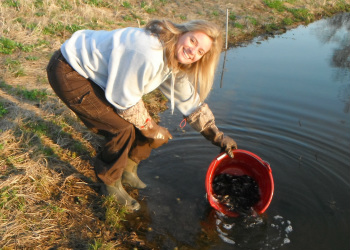 Jenny Fagin releasing fathead minnows. Jenny Fagin releasing fathead minnows. By Kevin Griffith What did I get myself into?!? I had just finished surveying my new lake with a consultant and the bad news was in. There was a HUGE amount of work to do to get it back into shape. My new playground was vastly overcrowded with bass, had been stocked years before with WAY too many grass carp, was totally devoid of baitfish, had very little natural or artificial structure and needed every possible catfish and striper (yellow bass) removed. It was 2005 and I was only at the lake a few days to a week each month. How was I going to get all this done! Luckily, I wasn’t the only one who wanted to improve the fishing on the lake. At the time, there were close to 40 locals who were members of the Fyrne Lake Fishing Club, a club I inherited from the previous owner when I purchase the property. (It was formally called the Viar Lake Fishing Club.) Under the guidance of my lake consultant, I requested that each member keep every striper, catfish and grass carp they caught as well as every largemouth bass under 12”. To make it easier on the fishermen, we installed a holding pen/net at the landing for any fish not wanted. It worked! The fisherman started removing hundreds of small bass, stripers and the occasional catfish or grass carp. The members left in the net what they didn’t want to take home themselves while others removed what was there to add to their catch. While in Tennessee I even harvested from the net to provide meals for myself and my family. However, even with hundreds of fish being removed, the process wasn’t going as quickly as I wanted. There needed to be a faster way. There actually was a faster way! The lake consultant said the fastest and easiest way to fix the lake was to DESTROY IT! By destroy it, he meant to treat the lake with chemicals to kill ALL the fish. I wasn’t willing to do that! For one, it would take several years before the fishing would come close to what it was, even considering its current off balance condition. I also had the club members to consider. Suspension of the fishing club would be necessary for at least 3 years, maybe more. The reality of the situation was that I had just been blessed with the privilege of caring for this place, a dream of a lifetime! And I didn’t have a peace about intentionally killing hundreds of thousands of fish not to mention the countless number of other aquatic creatures in the lake, just to improve the fishing. At that very moment, I made a commitment to myself to work with what God had blessed me with and build upon the quality of the current fishery. So, I wasn’t going to kill all the life in the lake and start over. But that didn’t mean I wouldn’t aggressively explore other ways to achieve my goal! I had an idea! The lake consultant had used an electro-shock boat to survey the lake. That’s a boat that uses a combination of a generator, transformer box and electrodes to create an electrical field to temporarily stun fish without harm. During the survey we had shocked up over a 100 small bass, a catfish and a grass carp. What if I bought one to help remove unwanted fish from the lake! I could remove thousands! Not to mention the fact that shocking fish was just plain COOL! It’s the only guaranteed way to catch fish EVERYTIME! But, how was I going to obtain one? Was it even legal for a civilian to own one? Was it fair to the fish? Well, using it for pleasure fishing really isn’t fair. Shocking takes all the sport out of the hunt. But was it legal? I needed to do quite a bit of research before I purchased an electro-shock boat. I placed it on my wish list. Removing unwanted fish was only part of my three prong plan to improve the fishing in Fyrne Lake. The other two prongs involved pumping up the food chain and adding substantial quantities of fish structure. The food chain in Fyrne Lake had been decimated by the overpopulation of largemouth bass. They had eaten and were continuing to eat EVERY living thing they could fit in their oversized mouths. Standing on the shoreline of the lake you could see small bass lined up waiting for something to move. I would throw small stones in the lake and rather than swimming away, the bass raced toward the splash in the hopes they would be the first to eat whatever had fallen into the lake. No wonder fishermen complained about not being able to get their bait past the bass to catch the bream and crappie! Eventually we would remove enough of the small bass to make a difference (especially if I ended up getting a shock boat). But, that wouldn’t repair the damage the overpopulation of bass had brought upon the lake. The food chain had been broken. There wasn’t a single baitfish to be seen. But what species should I stock? Through my research, I discovered 4 bait species worth considering for Fyrne Lake’s needs: fathead minnows, golden shiners, threadfin shad and tilapia ... yes, tilapia! Tilapia is the same fish you’ve probably seen on restaurant menus and maybe even enjoyed. It’s a great tasting mild fish. What you probably didn’t realize is that its offspring make great baitfish! And, do they ever produce offspring! During the warmer months tilapia spawn every month producing thousands and thousands of baitfish. They’re also plant eaters, like grass carp. Tilapia don’t compete with your game fish for food. They actually provide your bass and crappie with a tasty snack and nourishing meal - tilapia young! Since tilapia are such prolific breeders, there is a danger of them overpopulating a pond or lake in warmer climates. However, being a tropical fish originally farmed for food in ancient Egypt, they are vulnerable to cold water temperatures and become sluggish as the water approaches 55F and eventually die by the time the water reaches 45F. As their metabolism slows down these fish become easy prey for game fish and fishermen (with dip nets). And, if you’re having a problem with weeds (we weren’t) an adequate initial spring stocking of tilapia will keep a lake or pond clear all summer. For me, I was more interested in the tilapia’s offspring filling the bellies of our starving game fish. I placed my order right away! Fathead minnows could also fill an important place in the ecosystem of Fyrne Lake. Otherwise known as tuffies (olive grey) or rosy reds (golden/red strain), these baitfish are very slender and average between 2 and 3 inches in length making them an ideal crappie bait and they are actually sold throughout the US for that exact purpose. In a new pond or lake (or one recently “cleansed”), you’ll want to stock baitfish a season or two BEFORE stocking your game fish to allow the baitfish to become established. Otherwise, all your breeder baitfish could be consumed before they have a chance to spawn. That’s especially true for fatheads. They’re slow moving and an easy target for a hungry bass or crappie. Since I wasn’t starting the lake’s fish population over from scratch, I had to find a way to give the fatheads a fighting chance to spawn, and I found it. Fatheads need dense structure to hide in… massive amounts to have a chance for enough to survive the numerous lurking mouths. I wanted these baitfish established, so I placed my order and immediately started placing all the brush we could round up along the edge of the cove next to our release point to provide immediate cover and spawning structure. Fatheads are fine for crappie and juvenile bass. However, to reach lunker size, bass require a greater ratio of protein vs expended acquisition energy than these fathead minnows could provide. The established bream in the lake were doing their best to provide that protein, they just couldn’t keep up with the demand. They needed help. The tilapia would serve as a stop gap measure, providing baitfish during the warm months, but they’d all die out by winter. I wanted to permanently establish a baitfish that in conjunction with a revitalized bream population, could provide what our bass needed to become monsters. Golden shiners filled the bill. Adult golden shiners average between 3” and 5” with a much beefier build than fatheads providing the desired protein ratio. I added them to my order! My plan was coming together! The fatheads were the first to arrive and as hoped, many made their way to the structure we placed in a nearby cove and soon began to spawn. When the golden shiners arrived, rather than just release all of them at the landing, I wanted to transport a portion of my purchase by boat a mile away to the very top of the lake. I believed that by spreading them out, I would double my chances of getting these fish established in Fyrne Lake the first try. The challenge was to transport a sufficient quantity from the landing on the boat without overstressing (killing) the shiners. Jenny Fagin, from Greenwater Fish Farm, came up with the answer. I had found Jenny online while looking for a baitfish source. Located in Milan, Tennessee, Greenwater Fish Farm supplies a variety of baitfish and game fish as well as grass carp and tilapia. Jenny and her husband Dan founded Greenwater in 1997. Both with degrees in aquaculture from Auburn, they have grown a successful business serving several adjoining states providing sport fish for privately owned ponds and lakes. With her dad, Ed Davis, they supply baitfish across the mid-south, food size tilapia to local grocery stores and fingerlings across the nation. When I discussed my plan of moving a large quantity of the golden shiners to the far end of the lake, she immediately shared the solution. Jenny explained how she transports fish by truck for long distances by feeding pure oxygen into water through stones (like a fish tank pump) or pipes with numerous small holes. This process provides ample oxygen to densely pack a container with fish, especially the relatively short distance we were going to travel by boat up the lake. We now had a plan! On the day Jenny brought the shiners, she released most of the fish from the landing while the rest we gently placed in a 55 gallon drum in our boat. Oxygen pumping full blast, we quickly started our trek to the top of the lake. It seemed like it took forever! The extra weight of the water in the drum (400+ lbs.) made the boat ride low in the water and slowed our progress. I kept checking on the fish, making sure they weren’t gasping for oxygen at the surface. So far, so good! We finally made it to the top and started the release. Almost every fish made the journey! Only a couple floated limp in the water. It was normal to lose a small percentage on a transport and considering that we had just moved several hundred, losing a fraction of 1% was a success. Now all that was left was to stock the tilapia I had ordered. Jenny checked the water temperature and confirmed that we needed to wait another month until the lake would be warm enough. May came and so did the tilapia! I was amazed to see the variety of colors ranging from dark brown, orange, pure white and every mixture in between. The ones Jenny delivered that day were about the size and shape of a mature bream with a slightly longer & thicker body. These tough looking little fish quickly spread throughout the lake and did what they do best, spawn! In fact, I was amazed to see a cloud of fish fry along the shoreline that very same day! How could that be? I Googled tilapia and discovered that some varieties are mouth brooders. After the laid eggs are fertilized by the male tilapia, the female fish will scoop them up in her mouth, incubating them until the hatchlings are ready to swim out on their own. At least one of my stocked fish had a mouthful of fry! Boy, this effort at bringing Fyrne Lake’s fishery back was becoming quite an adventure and learning experience. My efforts so far of removing unwanted fish, flooding the lake with hundreds of thousands of tilapia fry through stocking breeder tilapia, and establishing baitfish back into the food chain was beginning to turn the lake around. However, there was still much more to do! The lowest rung of the food chain, plankton, needed to be pumped up to maximize Fyrne Lake’s potential. That would involve fertilizing the lake… a potentially dangerous proposition! Done incorrectly, a fish kill can result. There was also one more baitfish I wanted to investigate, threadfin shad. I’ll cover both of these subjects in my next article. 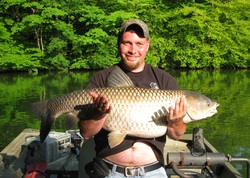 I have to do what?!? “To get your lake into shape you have to remove thousands of under 12 inch largemouth bass, remove every grass carp, catfish and striper (yellow bass) you can, fertilize the lake each spring to create a bloom, reestablish baitfish in the lake and create acres of fish structure”, my lake consultant calmly stated while handing me the bill for evaluating my lake. Man, what did I get myself into?!? Actually, it was exactly what I wanted. I had dreamed for decades about having a lake to care for, improve and maintain. And boy, this lake needed me! My wife and I purchased this beautiful 110 acre lake surrounded by woods just outside of Dyersburg, TN back in 2004. It was the realization of a dream. But now, just a few months after realizing the dream, it was meeting with reality. “Are there any other options?” I begged. “Yes, you could kill all the fish in the lake and start over. However, you would still have to add acres of fish structure.” he said. Why was all this necessary? My dream for the property extended way beyond maintaining the lake. I wanted to maintain and improve the property as a private natural park. But not just for my wife, children and me, but for later generations. I dreamed of it becoming financially independent through developing multiple income sources that wouldn't compromise the private park like setting through development or overuse. One already established income source was the fishing club on the lake. The previous owner started the club in the early 80's, just a few years after the lake was completed. Like most newly created lakes, the stocked fish quickly grew in size and expanded their population. For years the fishing was incredible with huge bass (up to 10 pounds), abundant bream (sometimes up to 2 pounds) and a growing population of clandestinely stocked white crappie (the crappie were seeded secretly by a fishing club member with the aid of a friend with an airplane). The fisherman were happy and so was the previous owner. Over 25 years later, the lake was showing signs of age. Like most man made impoundments, Fyrne Lake (formally known as Viar Lake) had been taken over by thousands of small bass. Largemouth bass are prolific breeders and eaters. They will eat any living thing that can fit in their oversized mouth. Depending upon their size, a female bass will lay between 2000 and 40,000 eggs! This invasion of hungry mouths began consuming everything in sight, including other bass. The existing fishing club members were frustrated by the small bass that kept taking their line, making it difficult to catch the bream, shell cracker (redear), crappie or the larger bass they sought. They shared stories and pictures of the way things used to be. I wanted to help, not only to keep the fisherman happy. I also loved to fish and I wanted Fyrne Lake to be the best it could be! But, I knew nothing about how to do it! Honestly, that was part of the appeal. I enjoyed learning, especially if it was going to help me conquer a new challenge. I just didn’t realize how much of a challenge it was going to be to turn things around! 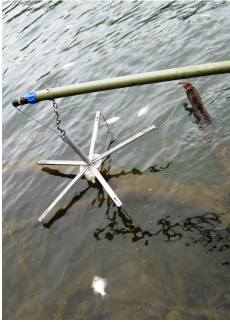 I started my research by scanning the internet, subscribing to a magazine called Pond Boss and located a lake consultant to provide a professional evaluation. I quickly began accumulating a library of information on lake management and it lead me to the realization of how many variables there were to achieve the quality of fishing I envisioned. I was hoping the lake consultant could help me formulate a long-term strategy. Luckily, it wasn’t long before he rolled up to the farm with his shock boat in tow. A shock boat comes equipped with a customized generator, transformer box and electrodes to suspend in front of the boat on one or two poles. Through adjusting the voltage, amperage and cycle frequency on the transformer box, a shock boat can gently stun fish, bringing them to the surface. The goal is to net, identify and measure the fish before they wake up and rush away. They don’t like being shocked any more than I enjoyed touching the electric fence as a kid on my grandmother Fyrne’s farm. However, just like my experience with her fence, the fish quickly recover without any negative long-term effect. The trip on the lake with the consultant turned out to be an amazing adventure! As we left the landing he fired up the generator and adjusted the dials on his transformer box. He shared how every lake is different and requires different settings to effectively bring up the fish. Variables like water conductivity, PH and temperature effect how deep the adjustable electrical field penetrates. Also, various fish species respond differently to the electrical settings. Experience and experimentation are necessary to “dial in” the proper output to bring up fish. Fortunately, my lake consultant was very experienced and it wasn’t long before we were seeing multiple fish floating to the surface. This was a fisherman’s dream! Fish were popping up all around us! I wanted one of these! We began netting the fish and bringing them into the boat for evaluation. Most of the bream were huge, but the bass were small and skinny looking. We released all the bream, but placed the smaller bass in an aerated tub to be weighed and measured when we returned to the landing. A key indicator of the health of the lake was going to be found through analyzing the condition of the bass population (more on that later). It was interesting to watch the consultant guide his boat along the shoreline seeking out structure to shock just as a fisherman would target the same area with a lure. Like clockwork, a promising looking structure would yield fish. Most continued to be bream and small bass with the occasional striper (yellow bass). However, we did shock up several large healthy looking bass and one huge blue catfish. Every large bass we weighed, measured and tagged on the spot then gently released them back into the lake. The catfish was another story. We kept him! As the day went on, the consultant observed that he hadn’t seen ANY aquatic plants and except for a few fallen trees along the shoreline and rotting stumps in the shallow end, the lake was devoid of structure. On a positive note, he added that the bottom contours were interesting. His depth finder was revealing numerous underwater ridges running out from shore with steep drop offs of up to 30 feet. However, even with the bottom contours, there wasn’t near enough structure for a lake our size. The reason for the absence of aquatic plants was soon revealed! As we approached the shallows at the top of the lake the water came alive! The combination of our presence and the electrical field around the boat had disturbed a school of grass carp. They were huge! Luckily, we were able to creep close enough to stun one. As the behemoth rolled up to the surface, the consultant’s assistant slipped a net over his head. The net barely stretched past his gill plates! Now it was my turn. I took my net and tried getting it around the grass carp’s tail. As I bumped it the fish came to and darted forward driving deeper into the net around its head almost ripping it from the assistant’s hands! Desperately, I forced my net around the thrashing tail and the two of us heaved the fish aboard. He seemed even larger in the boat! It was all I could do to lift him up with the scale to reveal a weight of 44 pounds! And this was just one of who knows how many grass carp in the lake. These grass carp don’t jump like the Asian carp that have invaded the Mississippi and its tributaries. They’re also sterile and are often used in lakes to help control aquatic vegetation. It turns out the previous owner had intentionally stocked these grass carp in the lake to take care of a weed problem… problem was he stocked too many… about a thousand too many! And these fish were keeping every sprout of aquatic vegetation that reared its head consumed. They had even “hedged” the overhanging tree branches of any leaves they could reach from the lake’s surface. (I later received reports of fisherman in the fall seeing these monsters waiting under oak and persimmon trees to catch the acorns and fruit as they fell!) Man! This lake had issues! But wait, there’s more! The lake consultant had not seen ONE single baitfish in the lake! With a knowing look on his face, he turned the boat back toward the landing. Even though he knew what the results would be, he and his assistant meticulously weighed and measured each of the hundred plus small bass in the tub. Using the chart included with this article, they compared the stats. ALL of the bass measured were underweight for their length. A healthy 12” largemouth bass should weight 14 ounces (see chart). Why did our 12” bass only weight 10 to 12 ounces? “Because they are starving!” was his answer. Largemouth bass had terribly overpopulated Fyrne Lake to the point where these fish had consumed all of the baitfish (that’s where they all went!) and were eating the majority of the small bream and crappie fry before they had a chance to mature… and they still didn’t have enough to eat! 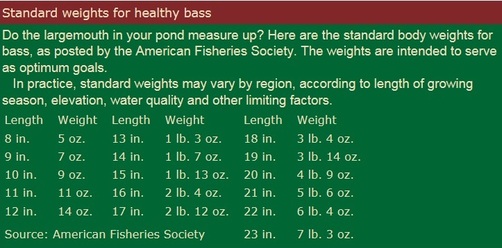 Reprinted with permission from Pond Boss Magazine Reprinted with permission from Pond Boss Magazine As the day went on, the consultant observed that he hadn’t seen ANY aquatic plants and except for a few fallen trees along the shoreline and rotting stumps in the shallow end, the lake was devoid of structure. On a positive note, he added that the bottom contours were interesting. His depth finder was revealing numerous underwater ridges running out from shore with steep drop offs of up to 30 feet. However, even with the bottom contours, there wasn’t near enough structure for a lake our size. The reason for the absence of aquatic plants was soon revealed! As we approached the shallows at the top of the lake the water came alive! The combination of our presence and the electrical field around the boat had disturbed a school of grass carp. They were huge! Luckily, we were able to creep close enough to stun one. As the behemoth rolled up to the surface, the consultant’s assistant slipped a net over his head. The net barely stretched past his gill plates! Now it was my turn. I took my net and tried getting it around the grass carp’s tail. As I bumped it the fish came to and darted forward driving deeper into the net around its head almost ripping it from the assistant’s hands! Desperately, I forced my net around the thrashing tail and the two of us heaved the fish aboard. He seemed even larger in the boat! It was all I could do to lift him up with the scale to reveal a weight of 44 pounds! And this was just one of who knows how many grass carp in the lake. These grass carp don’t jump like the Asian carp that have invaded the Mississippi and its tributaries. They’re also sterile and are often used in lakes to help control aquatic vegetation. It turns out the previous owner had intentionally stocked these grass carp in the lake to take care of a weed problem… problem was he stocked too many… about a thousand too many! And these fish were keeping every sprout of aquatic vegetation that reared its head consumed. They had even “hedged” the overhanging tree branches of any leaves they could reach from the lake’s surface. (I later received reports of fisherman in the fall seeing these monsters waiting under oak and persimmon trees to catch the acorns and fruit as they fell!) Man! This lake had issues! But wait, there’s more! The lake consultant had not seen ONE single baitfish in the lake! With a knowing look on his face, he turned the boat back toward the landing. Even though he knew what the results would be, he and his assistant meticulously weighed and measured each of the hundred plus small bass in the tub. Using the chart included with this article, they compared the stats. ALL of the bass measured were underweight for their length. A healthy 12” largemouth bass should weight 14 ounces (see chart). Why did our 12” bass only weight 10 to 12 ounces? “Because they are starving!” was his answer. Largemouth bass had terribly overpopulated Fyrne Lake to the point where these fish had consumed all of the baitfish (that’s where they all went!) and were eating the majority of the small bream and crappie fry before they had a chance to mature… and they still didn't have enough to eat! 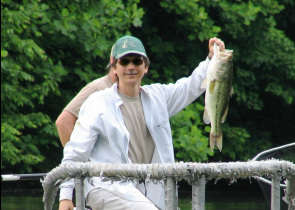 Any body of water had a set number of pounds of predator fish it can support depending upon fertility with all other factors remaining constant. What that means is if your lake can support 10,000 pounds of predator fish, your make up could be 1,000 ten pound fish, 10,000 one pound fish or some combination in between. Reducing the number of predator mouths will concentrate the food source in the remaining fish to make them larger. We had so many largemouth bass mouths to feed most of ours were not even reaching a pound! He explained how controlling the bass overpopulation was necessary to accomplish any improvement in the fishing. But, that was just the first component of what was needed. The lake was supporting only a fraction of the fish population possible because of limited habitat and food sources. Between the grass carp consuming all of the natural aquatic plant cover and the limited structure (fallen trees, stumps, brush, etc.) present in the lake, the fish had few places to hide long enough from predators to mature. The food chain had also been disrupted by the bass consuming every last baitfish. We needed to reestablish baitfish in the lake while also providing cover for them to hide in and reproduce. Fertilizing the lake to create a controlled plankton bloom in the late spring would provide an ample food source for the baitfish pumping up the number of pounds of predator fish the lake could support. However, we needed to be cautious. Over fertilization can cause a fish kill. To bring Fyrne Lake up to where it needed to be, I had some decisions to make. (Next article: Our Lake Management Plan) Every year we team up with the City of Dyersburg to recycle Christmas trees. Here is a video of our Christmas tree fish structure project--We hope you enjoy! Post by Fyrne Lake. |
AuthorKevin Griffith Archives
September 2018
Categories |
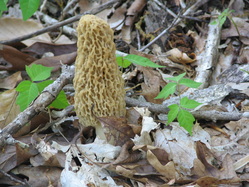
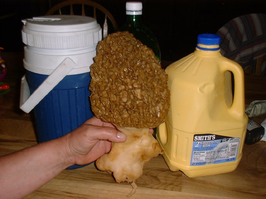
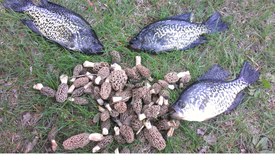
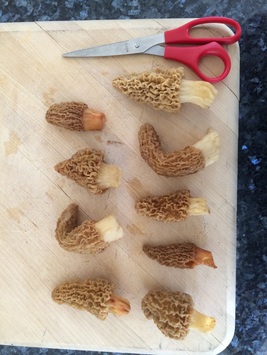
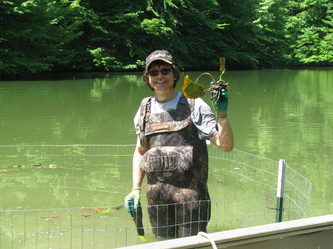
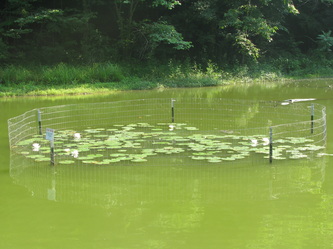
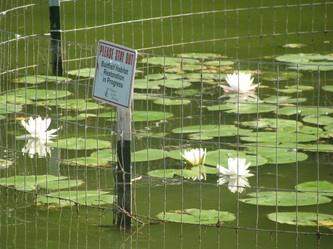
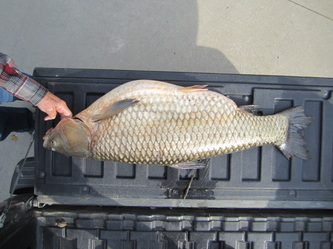
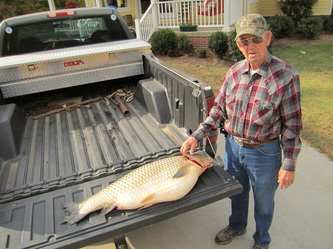
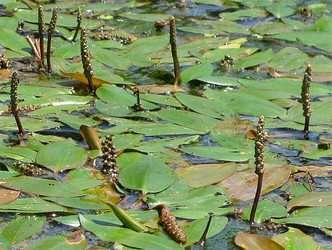
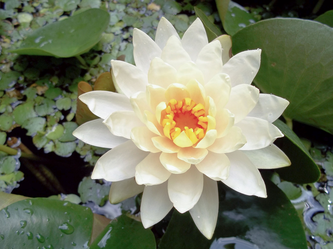
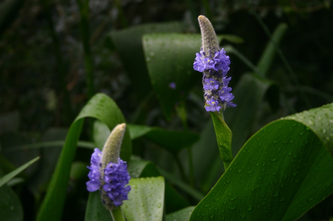
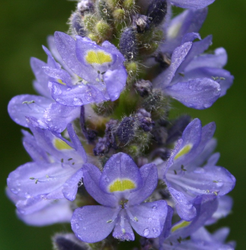
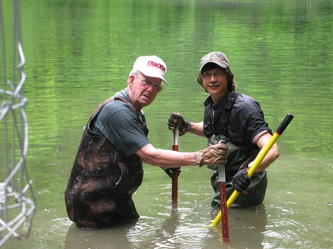
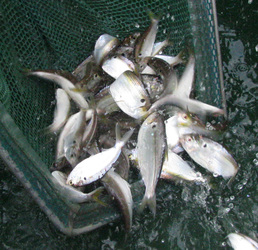
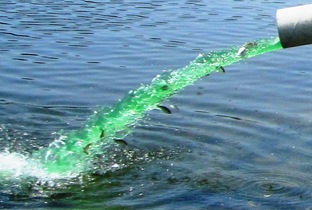
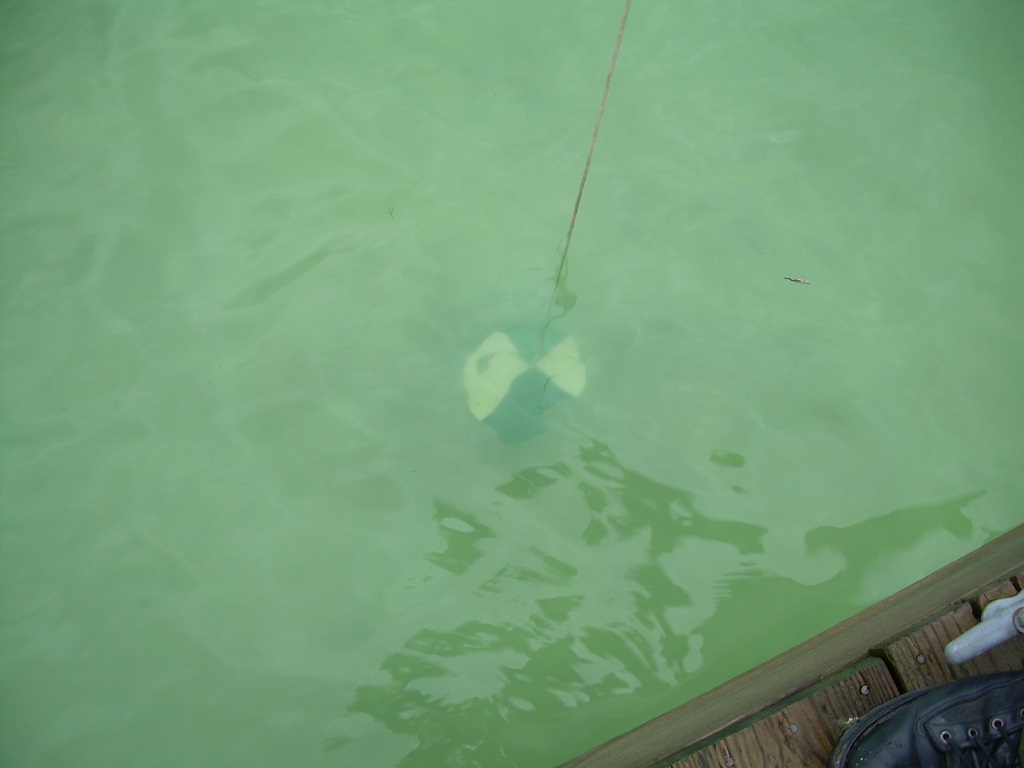
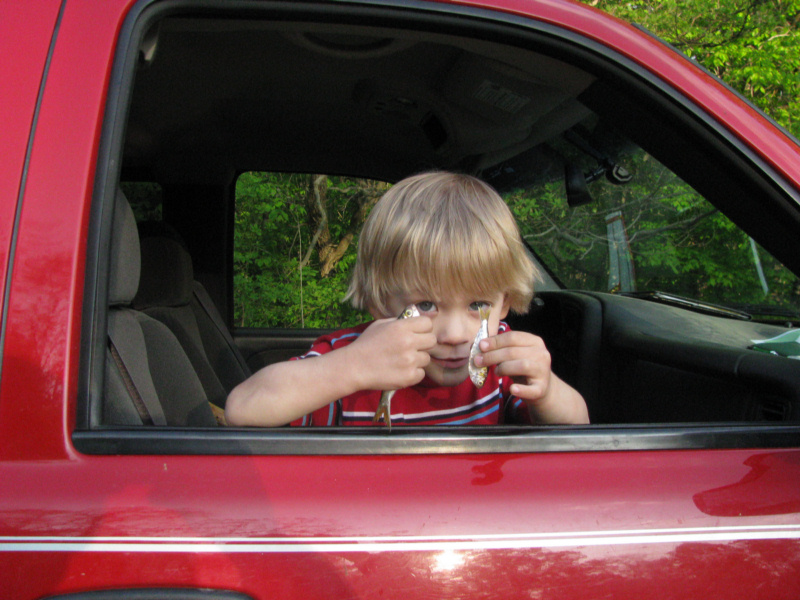

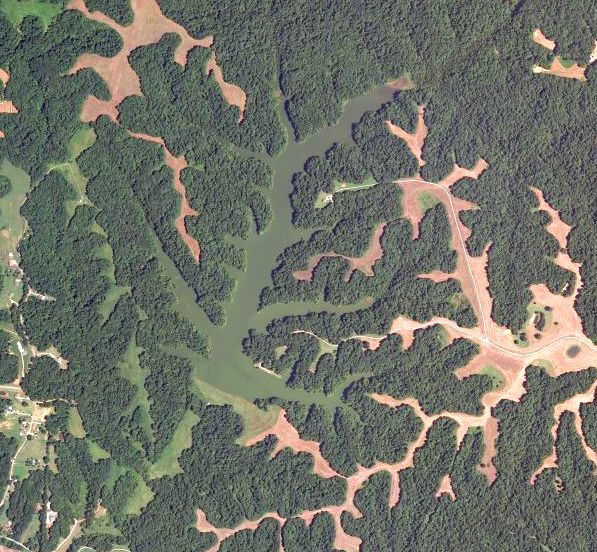
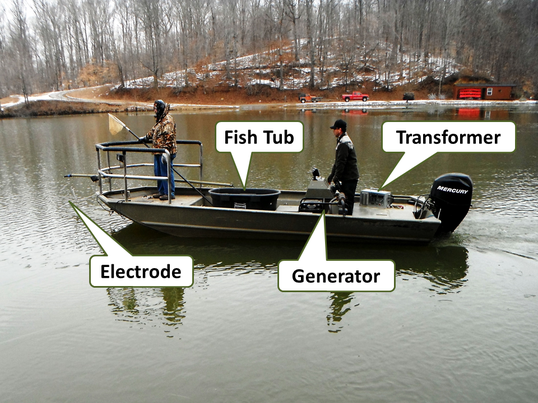
 RSS Feed
RSS Feed